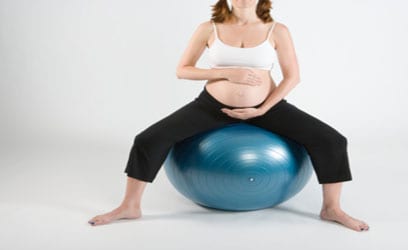Pregnancy can be the most stressful time in a woman’s life. Exercising through the next 40 weeks will help prepare you for labor and give you an overall sense of well-being. You’ll benefit from less constipation, sleep better and exercise will help your body to accommodate to its changing size. Be sure to discuss your exercise plans with your health care provider and take into consideration any restrictions and recommendations they have.
Listen to your body—if you feel dizzy, have heart palpitations, shortness of breath or experience pelvic pressure, stop exercising immediately and contact your health care provider if the symptoms persist.
The First Trimester
If you have been active before your pregnancy, you should be able to keep at it with slight modifications to your routine. If your pregnancy has been a catalyst to begin exercising, the American Pregnancy Association suggests taking it slowly and be careful not to overexert yourself. Listen to your body as it will give you signals when it needs you to slow down. Do not exercise to the point of breathlessness or exhaustion—you and your baby are not getting the oxygen you need and that can put you both in danger.
During your first trimester you’re likely to have periods of dizziness, nausea and fatigue. Listen to your body and adjust your workout as needed.
During pregnancy, especially the first trimester, it’s important that mom does not get overheated. Be sure to take frequent breaks and drink plenty of fluids. Do not exercise in hot weather.
Walking, running and swimming are all great exercises during the first trimester. Stay away from roller-blading, basketball, softball or other contact sports for the remainder of your pregnancy.
The Second Trimester
As your baby grows, your center of gravity will begin to change. This may cause balance issues, so as you exercise be sure to take into account these changes. Stay away from uneven ground, lateral movements (such as playing tennis) and take extra caution when riding a bike.
During this trimester you’ll also want to be sure not to do any exercises that require you lie flat on your back because this decreases the blood flow to your baby. You may continue to lift weights—focus on toning of the muscles not bulk and don’t lift any weights above your head.
Along with a shift in balance, a pregnant woman’s body also experiences joints that are more relaxed than normal. Be sure to wear supportive shoes and stay on even ground.
During this trimester you’re likely to have a lot of energy, but you may need to adjust your workout routine to accommodate your growing body.
It is recommended that you begin prenatal yoga in your second trimester, and you should continue swimming and walking (adding time and/or hills to your workout if you feel good) and weight lifting. Be sure to add in stretching and relaxation exercises.
The Third Trimester
Your body may be sending you some big signals concerning your workout. It’s important to remember how much work your body is doing in growing the little one in your belly and to listen to what it’s telling you.
For most women, running will now become uncomfortable and is not recommended. Talk with your provider about your exercise routine as you enter these last few months.
Continue to avoid exercises that include you lying on your back—you may find yourself feeling dizzy and nauseous if you do. Take frequent breaks as you exercise and be sure to drink plenty of water. Listen to your body.
Continue with walking, swimming and yoga. While lifting weights, alter your exercises to accommodate your body.





